AT89S52 QuickStart Board V2
AT89S52 QuickStart board is user friendly, multipurpose programmable board for beginners as well as high end users. This is a Low Cost Development Board that can be used to quickly evaluate and demonstrate the capabilities of Atmel AT89S52 / AT89C51 / AT89S51 / AT89C52 microcontrollers. The board is designed to work as a header providing access to all pins for external connections, ideally suitable for quick start development purposes.
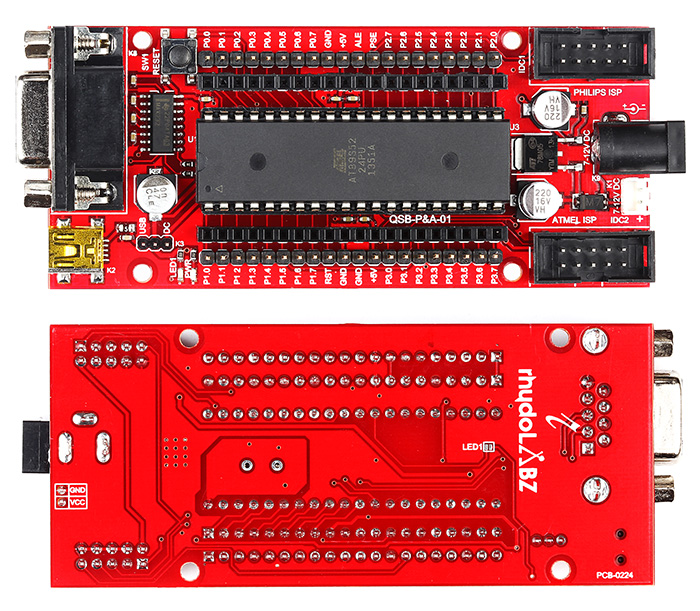 QSB AT89S52 Features:
QSB AT89S52 Features:
- Compact and Ready to Use design
- Compatible with Atmel AT89C51 / AT89C52 / AT89S52 controllers
- Includes Atmel AT 89S52 Microcontroller
- No Separate power adapter required (USB powered)
- All Port Pins available at Male Berg Strip and at female Berg housing connector
- Separate ICSP Port for Atmel and Philips Controllers, available in 5X2 IDC connector
- RS232 Interface (For direct connection to PC’s serial port )
- External supply ranges from 7V to 20V DC
- On Board 11.0592 MHz Crystal Oscillator
- On board Reset Switch
- On board power indicator LED
- On Board Port Pin LED connection for Board checking ( Jumper Selectable)
- On Board 5V,1Amp Voltage Regulator
- RMC connecter & DC Barrel Jack for External power Supply (with Jumper Select Option)
- Power Supply Reverse Polarity Protection
- Can be used as header board for developing applications
- Two layer High Quality PTH PCB
AT89S52 Chip Features:
- 8K Bytes of In-System Reprogrammable Flash Memory
- Fully Static Operation: 0 Hz to 33 MHz
- Three-level Program Memory Lock
- 256 x 8-bit Internal RAM
- 32 Programmable I/O Lines
- Three 16-bit Timer/Counters
- Eight Interrupt Sources
- Programmable Serial Channel
- Low-power Idle and Power-down Modes
- 4.0V to 5.5V Operating Range
- Full Duplex UART Serial Channel
- Interrupt Recovery from Power-down Mode
- Watchdog Timer
- Dual Data Pointer
- Power-off Flag
- Fast Programming Time
- Flexible ISP Programming (Byte and Page Mode)
Layout:
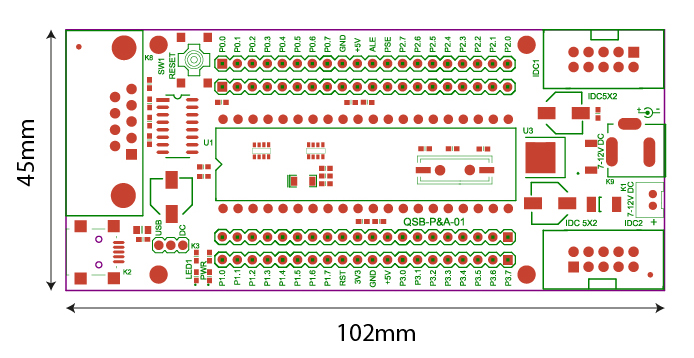 How to test:
How to test: 
Mini USB(only for powering) and Serial Cable is used to download program to AT89S52 QuickStart board. When USB cable is connected to the AT89S52 QuickStart board, “PWR LED”(Red) on the top of QuickStart board module glows, which shows the power indication. Follow the steps below to get started with programming your AT89S52 using the rhydoLABZ Quick Start Board(QSB).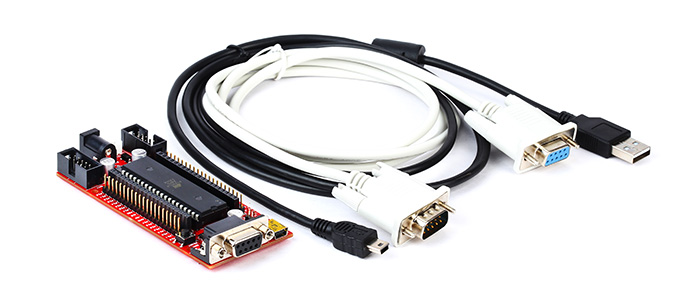
- Step 1: Launch Keil uVision3(click here to download)

- Step 2: From Keil uVision3 menu bar, select Project > New Project.

- Step 3: The following window opens. Save the project by providing suitable project name. In the example shown here project is saved by the name ‘led’ as shown in the figure below.

- Step 4: Up on saving the project following window opens. Select the device (AT89S52) to be programmed from the drop down list provided in the window; in the list provided devices are grouped under their manufacturers name (AT89S52 is an ‘Atmel’ make and therefore it can be found under the tag ‘Atmel’ as shown below). After selecting the device click “OK”.

- Step 5: Select whether you need the standard 8051 startup code or not.

- Step 6: Right click Target 1 and select ‘Options for Target ‘Target 1’’.

- Step 7: A window opens with options for the target. From the ‘Target’ tab > Select Xtal(Mhz):11.05
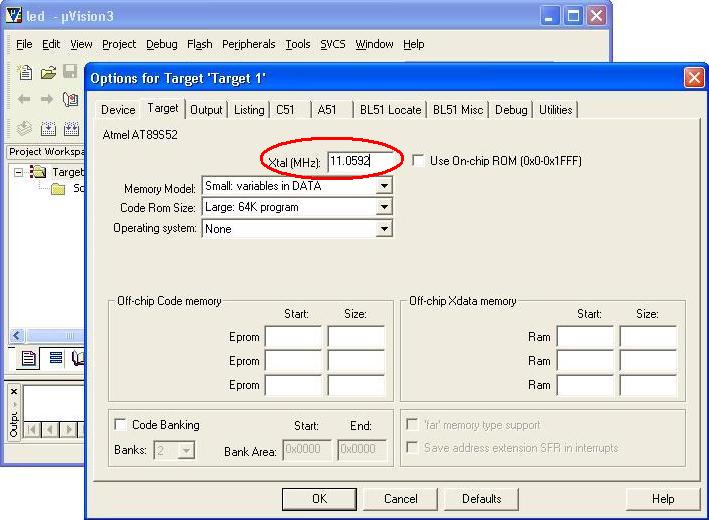
- Step 8: Now on the same window, from the ‘Output’ tab > Make sure the ‘Create HEX File’ box is checked and click OK.

- Step 9: From the main window select the New File icon or select File > New or press Ctrl + N. A new window will opens.

- Step 10: Enter the code to be programmed on to the controller in this new window. Here the code for LED blinking(LED1 connected to seventh pin of PORT0 is shown in the figure as an example.

- Step 11: Now select File > Save As or press Ctrl + S and save the file using suitable file(blink is the file name used here) name with a .c extension.

- Step 12: Right click Source Group and select ‘Add Files to Group’.

- Step 13: Browse the program file with the .c extension(one that was saved in the previous step). And click ‘Add’ to add the program file to your project (in this example blink.c).

- Step 14: Now build the project by clicking the build option in the main window (build option is marked in red in the figure shown below).
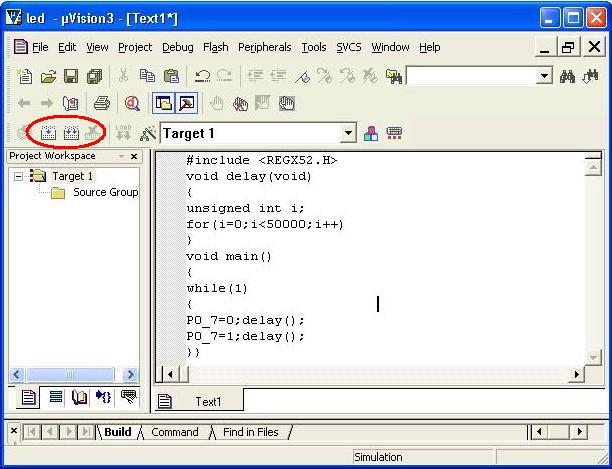
- Step 15: Now on building the project errors and warnings (if any) get listed in the output window. Here in this example a syntax error is illustrated in the figure below (on line number 5; missing semicolon) just to show how the window appears upon an error. Correct the error and build again.
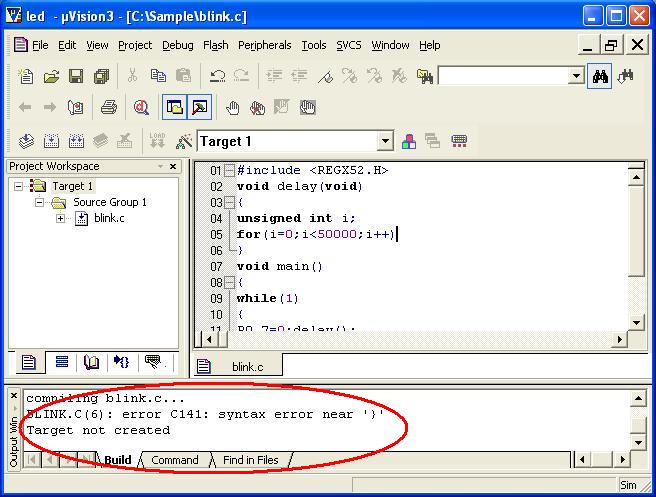
- Step 16: On successful building, the hex file(named after the project) will be generated in the project folder. In the example shown here hex file ‘led.hex‘ will be created in the project folder.
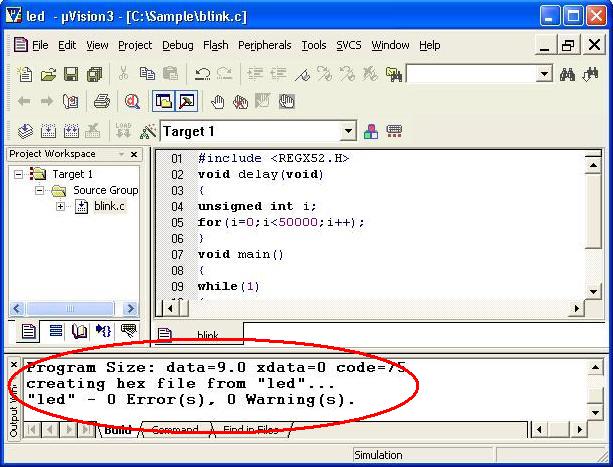
- Step 17: Now to load this program to the controller on the QSB, connect the QSB via ISP to the PC(as shown in the fig below). The rhydoLABZ AT89S52 Quickstart Board is compatible with PHILIPS programmer as well as ATMEL Programmer with on board ISP connector pins for both. In this illustration program is loaded to the controller using the ATMEL Programmer.
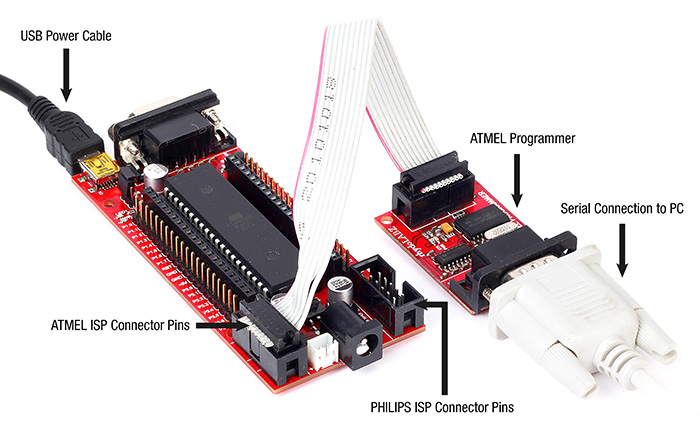
Make sure the programmer, used for loading the program, is connected to correct connector pins provide on board, i.e PHILIPS Programmer to PHILIPS ISP Connector pins and ATMEL Programmer to ATMEL ISP Connector pins respectively.
- Step 18: After connecting the QSB to the PC(as shown in the previous step), open the ISP_AT895 application(click here to download). The following window opens. In here select the Target Clock Frequency (11.0592 MHz).

- Step 19: After selecting the target clock frequency select File > Load Flash File and load the .hex file as shown in the next step.

- Step 20: Browse the .hex file (as shown in the figure below) from the project folder.

- Step 21: Now select the ‘Chip Erase’ option and run the same to erase any previous loaded program from the chip.

- Step 22: Select the ‘Write Flash’ option and click the Run button to write the program to the chip, status of the writing process will be shown on the bottom of the window.

Note: Before checking the above program, don’t forget to short jumper “LED1″ (connecting port pin to LED1 on the bottom side of Quick Start Board).
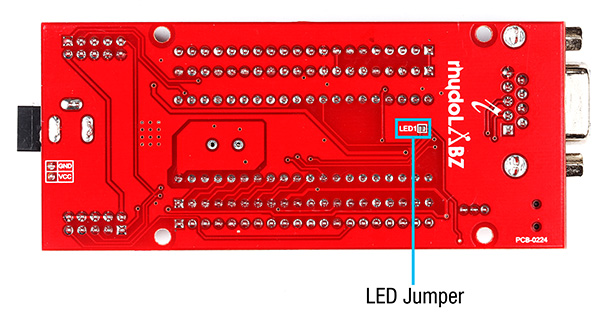
The image below depicts notable on board connections for the AT89S52 QSB. Resources:
Resources:
How to Buy:
Click here to buy the rhydoLABZ AT89S52 Quickstart Board V2
Click here to buy the rhydoLABZ ATMEL/PHILIPS Quickstart Board V2
Click here to buy the rhydoLABZ AT89S52-24PU Microcontroller
Click here to buy the rhydoLABZ ATMEL 89SXX ISP Programmer (RS232)
Click here to buy the rhydoLABZ Atmel ISP Programmer – USB
Support:
Please share your ideas with us, visit our forum for discussion
Frequently Asked Questions(FAQ):
Q.Is it possible to use any microcontroller other than AT89S52?
Ans.Yes. Other than AT89S52 the following controllers also can be used
AT89C51
AT89C52
AT89S51
Q.Is it possible to load the program directly using serial connection (without using the ATMEL/PHILIPS programmer)?
Ans.No, ATMEL/PHILIPS ISP Programmer is required for loading the program on to the controller on the QSB.
Q.Is it possible to supply power to the QSB using any other connection other than USB?
Ans.Yes, Power can be supplied to the QSB using 7-12V DC supply too, Power supply connection can be selected between the DC supply and USB power using the power jumber provided on the board near the power LED.

Leave a Reply
You must be logged in to post a comment.